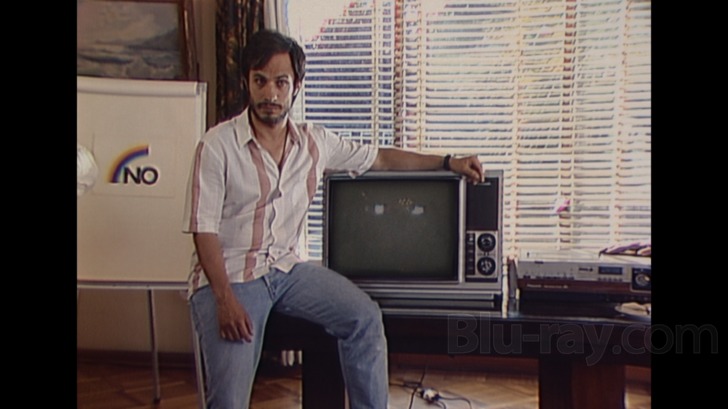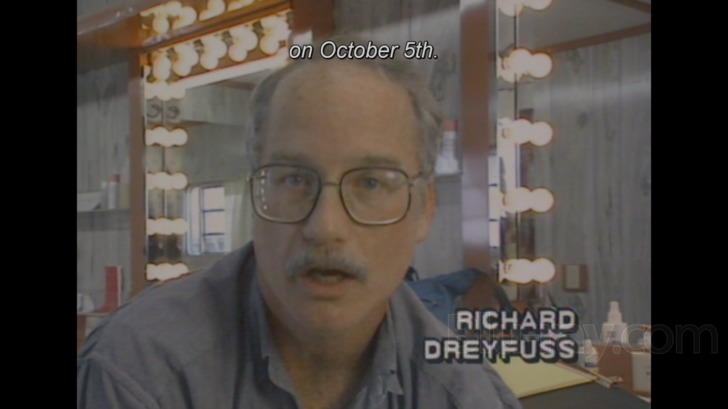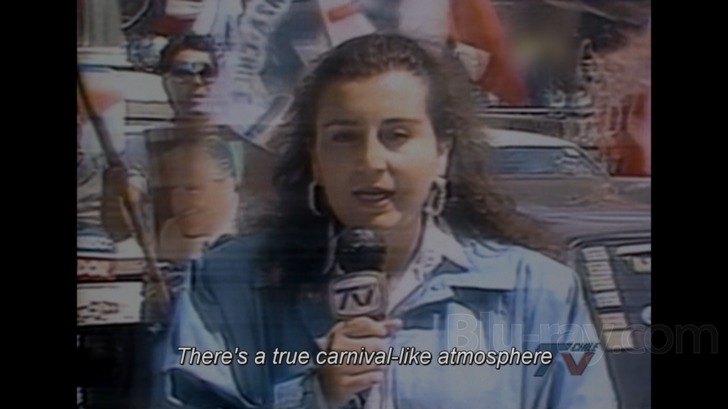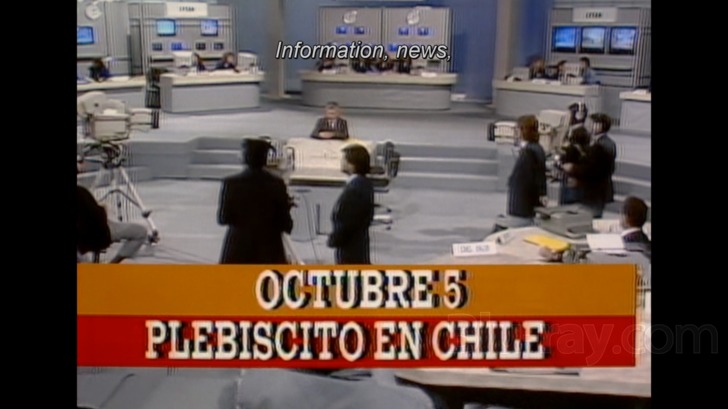No Blu-ray Movie
HomeNo Blu-ray Movie 
Sony Pictures | 2012 | 118 min | Rated R | Jun 25, 2013
Movie rating
7.6 | / 10 |
Blu-ray rating
| Users | 3.8 | |
| Reviewer | 3.5 | |
| Overall | 3.8 |
Overview
No (2012)
Military dictator Augusto Pinochet calls for a referendum to decide his permanence in power in 1988, the leaders of the opposition persuade a young daring advertising executive - René Saavedra - to head their campaign. With limited resources and under the constant scrutiny of the despot's watchmen, Saavedra and his team conceive of a bold plan to win the election and free their country from oppression.Pinochet is put to a national plebiscite.
Starring: Gael García Bernal, Alfredo Castro, Luis GneccoDirector: Pablo Larraín
| Foreign | 100% |
| History | 34% |
| Drama | Insignificant |
Specifications
Video
Video codec: MPEG-4 AVC
Video resolution: 1080p
Aspect ratio: 1.40:1
Original aspect ratio: 1.37:1
Audio
Spanish: DTS-HD Master Audio 5.1 (48kHz, 24-bit)
Subtitles
English, English SDH, French
Discs
50GB Blu-ray Disc
Single disc (1 BD)
Playback
Region A (locked)
Review
Rating summary
| Movie | 4.0 | |
| Video | 4.5 | |
| Audio | 4.0 | |
| Extras | 1.5 | |
| Overall | 3.5 |
No Blu-ray Movie Review
Diga "Sí" a 'No.'
Reviewed by Martin Liebman June 30, 2013It's difficult to remember a time when life didn't move at the speed of "now," when phone calls required looking in the White Pages and punching buttons or moving a dial; when sending a written message required pen, paper, stamp, and envelope; when television wasn't crisp and lifelike; when getting the word out took real effort, not a few clicks or keystrokes. Now, the iPhone can remember thousands numbers, call them up instantly, and dial them with a word. It can send off e-mails and text messages and videos and even allow people to see one another, live, while they talk, and in better quality than older televisions. Facebook posts and Twitter blurbs can reach millions in a matter of seconds. What a difference a few decades make. Remember 1988? It was still big hair, loud clothes, 8-bit Nintendo consoles, and bulky CRT televisions. Star Wars fans were blissfully unaware that Jar Jar Binks would forever haunt their beloved franchise. Friends were just a group of people who gathered to watch the game or go shopping for shoes. Nobody knew what an "MP3" was, and Michael Jordan hadn't yet won any rings. The Berlin Wall was still up, New Coke was on its way down, and politics, well, it was just politics as usual all around the world. Except in Chile. The South American nation, under international pressure, was to hold an up-or-down referendum on Augusto Pinochet's rule. The "Yes" and "No" camps were to get the word out through brief television exposure -- they didn't have all the fancy "get out the vote" tools available to campaigns today -- and one man's vision for how to craft a winning political message using the latest and greatest techniques was set to alter the course of history. Sure, it wasn't done with the help of RAM and gigabytes and WiFi and 3Gs or 4Gs or anything like that, but that one forward-thinker understood how to use the cutting edge to manipulate his audience on presentation, not simply hard data and boring facts and figures. If political manipulation has come this far in just a couple of decades-plus, where will it be in another few?

The ad man.
René Saavedra (Gael García Bernal) is a successful marketing guru. His ads don't always speak to everyone, but he's making ads that reach a new, younger demographic with themes of love, rebellion, and happiness the centerpieces of his campaigns. He's approached José Tomás Urrutia (Luis Gnecco), a man working in a political campaign against Chilean leader Augusto Pinochet, head of a military dictatorship that has ruled the country for well over a decade. International pressure has forced the General's hand; there's to be a plebiscite to determine his fate, and both sides -- the "Yes," keep Pinochet in power and the "No," remove him from office -- have been granted television air time to help persuade voters to their side. Saavedra agrees to work on the television spots. He finds the "No" group divided, unconfident in its chances at winning, and building up dour, hopeless advertisements that he believes will fail to find favor with modern Chileans. Despite some resistance, he begins crafting happier, more colorful ads that, as they air, begin to swing public opinion towards the "No" campaign. But will those ads be enough to create a real groundswell of support for a politically dangerous position?
Ever since that first televised Presidential debate between Richard Nixon and John Kennedy -- the one for which radio listeners favored Nixon's message but television viewers drifted towards the better-groomed and composed Kennedy over the sweaty, sickly Nixon -- the television has proven an invaluable tool in getting the message out. But is it really about the message or is it about the zinger or the style or, in the worst case scenario, the gaffe? Does anyone remember anything other than George H.W. Bush checking his watch or Joe Biden's endless guffawing and the rolling of his eyes? In No, a smart advertising executive on the cutting edge of the color television and popular culture revolution is called in to build a winning political advertisement. In a perfect world, laying out the facts and figures and persuading voters to decide completely on the merit of ideas would be ideal, but in the world of instant communication -- and even in 1988, things were pretty instant even without the ubiquitous smart phone and widespread Internet -- it seems like what voters see rather than what they hear is more important. As the movie plays out, audiences are left to wonder if all the flash and carefully constructed dialogue, lyrics, visuals, colors, settings, and everything else that goes into making the advertisement actually marginalize the message or hide the facts rather than truly inform the audience. Do these sorts of campaigns really result in any kind of real, substantive discourse or are they merely window dressing in the selection of a figurehead rather than the election of a real leader? Of course, the problem is grossly compounded today with an endless barrage of mailings, robo-calls, TV ads, tweets, texts, and all sorts of supportive elements that at best cross wires and at worst get completely off-message. No demonstrates in some detail the power of mass media to define a movement and shape a landscape, but not necessarily to get the truth out to a public that needs to know what, exactly, it is they are voting for with their up or down choice.
The filmmakers' decision to shoot as if a 1980s Documentary proves invaluable in further shaping the film's themes and not just reinforce its tone. It fully saturates the audience in the era, something a smooth, clean digital film could do but perhaps not quite with such immediate effectiveness as this, particularly in a fast-forward era in which much of the work almost feels ancient. As the movie looks its time and feels its time, the truest effect of the advertisements are understood in a greater cultural context, seeing them as they were and not as they might be today, because, frankly, they wouldn't exist today, especially not for mass consumption and even updated for the times. No is in many ways a time capsule and the organic flow of the film is greatly enhanced by that style. Likewise, the rather raw Documentary approach further emphasizes the immediacy of the campaign, brings the audience into the political arena, and makes each viewer a participant along every step of the way. While the outcome isn't in doubt -- whether audiences are familiar with the real history behind the campaign and the Pinochet regime's fate or not -- that full sense of immersion into the "No" campaign pulls audiences out of the present and back to a time when it was all very much in doubt, when every valuable second of airtime could be the difference between victory and defeat, when the fate of a nation fell into the hands of a TV ad man.
No Blu-ray Movie, Video Quality 

As mentioned in the film review, No was photographed as if it were made in the late 1980s, documenting the action in the old standard definition television aspect ratio and with standard definition quality. The picture, then, doesn't meet modern high definition standards of visual excellence, but that's balanced out by filmmaker intent and the Blu-ray's capture of the movie's natural appearance. As such, it scores highly for replicating the filmmakers' vision, which should be always first and foremost when evaluating a transfer. That said, it's not very pretty by modern standards. Details are soft, muddy, and absent any sort of positive definition and clarity beyond the basics. Colors, too, are lacking in vibrancy and stability. The palette is often murky and bleeds. Random halos, stray vertical lines, false colors, and all sorts of visual anomalies are present. Again, though, this is how the picture was intended to look. Anything else would be a betrayal to the content, and as such the Blu-ray transfer earns high marks.
No Blu-ray Movie, Audio Quality 

Unlike the video, No features a fairly active and modern DTS-HD Master Audio 5.1 lossless soundtrack. It always feels a bit discombobulating when something sounds way better than it looks. The "found footage" style of movies are always guilty of this, and while No doesn't fit into that category, it nevertheless features a soundtrack that feels engineered rather than natural, not captured on the fly or with lower grade recording equipment as is the case with the video. Nevertheless, the end product proves fairly dynamic, in places, and somewhat low-key in others. Listeners will enjoy a broad range of elements, from hushed but mood-defining background ambience at a restaurant (clanking silverware, light music) to the din of a busy office (ringing telephones, clanking typewriter keys). Ocean waves gently roll into the stage in one scene, a toy train encircles it in another, and the track often finds a good, precise posture for most of its sound effects. The track gains energy during some later scenes of rioting and intense street-level action. Alarms, crashes, and all variety of mayhem fill the stage with some aggression. Dialogue plays smoothly and accurately from the center. It's a well-put-together track, though audiences may find it doesn't always quite match the visual presentation.
No Blu-ray Movie, Special Features and Extras 

No contains only two primary supplements.
- Audio Commentary: Gael García Bernal and Pablo Larraín discuss the film, in English. They sometimes jovially, though often seriously, cover the picture from a number of perspectives. They speak on the technical attributes, the real era elements used in the film, the politics and culture of the era, post-production tricks, character development, themes, the cast, and plenty more. This is a highly enjoyable track that will please fans.
- Q&A with Gael García Bernal (HD, 12:47): Moderator Diana Sanchez hosts the actor after a screening.
- Theatrical Trailer (HD, 2:03).
- Previews: Additional Sony titles.
No Blu-ray Movie, Overall Score and Recommendation 

No tells a fascinating tale about political messaging and style that's just as relevant today as the real McCoy was decades ago. It's a movie that shows the power of political persuasion and manipulation not through hard facts and figures -- and sobering ones at that, in this case -- but rather a change in tone that makes it hip and cool to favor one side over another. Such techniques are a given today, but No tells an early story of how modern mediums can reshape an age-old landscape. Supported by a smart, engaging throwback visual style and great performances, "yes" should be the answer when questioning whether to see No. Sony's Blu-ray release of No features quality video and audio. Unfortunately, the supplements are a little on the thin side. Recommended nevertheless.
Similar titles
Similar titles you might also like

The Battle of Algiers
La battaglia di Algeri
1966

Che: Part One
2008

Of Gods and Men
Des hommes et des dieux
2010

City of Life and Death
南京!南京! / Nanjing! Nanjing!
2009

Confucius
孔子 / Kong zi
2010

Kagemusha
影武者
1980

Loveless
Нелюбовь / Nelyubov
2017

Aquarius
2016

The Rocket
2013

The Official Story
La Historia Oficial
1985

The Club
El Club
2015

Missing
1982

Pioneer
Pionér
2013

Le Petit Soldat
The Little Soldier
1963

Never Look Away
Werk ohne Autor
2018

Coup d’état
戒厳令
1973

The Story of Adele H.
1975

Army of Shadows
L'armée des ombres
1969

The Flower of Evil
La fleur du mal | 4K Restoration
2003

The Image Book
Le livre d'image
2018